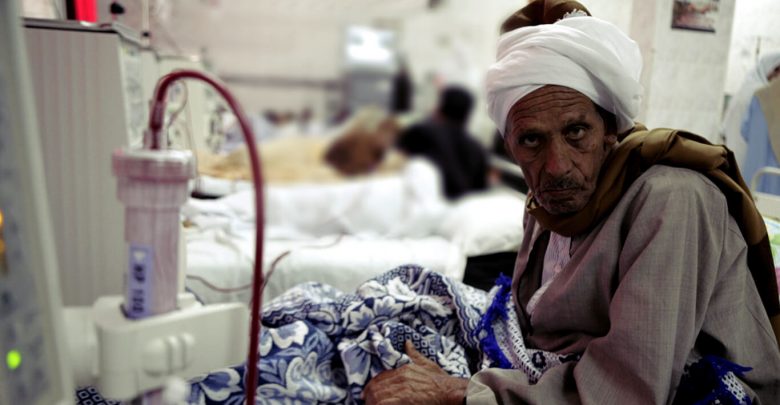
Egypt’s Universal Health Insurance System
The universal health insurance system in Egypt is one of the most important projects that Egyptians have dreamed of, particularly during the past few decades. However, politicians have always used the project to make temporary gains by frequently promising citizens that they are on the verge of achieving their dream of getting a good medical service. With the outbreak of the Jan. Revolution (2011) and its demands of social justice, the hopes of Egyptian people escalated, with respect to possibility of acquiring their basic rights, most notably the right to healthcare.
However, all governments that came after the January Revolution adopted the idea of a universal health insurance system that addresses the distortions of the current health insurance system and provides a satisfactory health service for all citizens. However, the idea did not receive necessary discussion due to political and security instability at the time. Although the universal health insurance law was issued in December 2017, and its executive regulation was issued on 5 May, however the law has not yet been put into force in spite of the fact that Abdel Fattah al-Sisi issued a decree on the fifth of July for launching the scheme’s first phase as stated by the law.
This paper addresses past experiences of the health insurance issue and attempts to identify similarities and differences with the system presented by the new law. The study also introduces an analytical vision of significant problems related to the law.
General Features of the law
According to the new law, contributions to the health insurance system are based on an individual’s total income. It is also binding on the head of the family to pay for his wife, if she does not work, and dependent children. Also, contribution rates differ according to the individual’s employment status (e.g. pensioner, widows, etc.). Employers will have to pay their share of the contributions of their employees, amounting to 4% of the total wage of the insured worker (3% sickness insurance + 1% work injury). Apart from employers and employees, sources of funding for the scheme include external and internal grants and government loans, donations, cigarette and tobacco taxes, highway tolls, driving license renewal fees, vehicle license fees, etc. The new system allows contracting with private hospitals, and police and army hospitals as long as they meet control and qualifications requirements.
The implementation of the new health insurance scheme takes place over six stages as follows:
| Phase |
Period |
Places |
|
1 |
2018-2020 |
South Sinai, North Sinai, Ismailia, Port Said, and Suez |
|
2 |
2021-2023 |
Luxor, Matrouh, the Red Sea, Aswan, and Qena |
|
3 |
2024-2026 |
Alexandria, Damietta, Beheira, Kafr El Sheikh, and Sohag |
|
4 |
2027-2028 |
Beni Suef, Assiut, Minya, New Valley, and Fayoum |
|
5 |
2029-2030 |
Dakahlia, Gharbia, Sharqiya, and Menoufia |
|
6 |
2031-2032 |
Cairo |
General remarks on the law
– It is apparent that the new law has transferred (financial) commitment from the State as stipulated by the Constitution to the individual and society, a clear violation of the provisions of Article 18 of the Constitution which stipulates that: “Every citizen has the right to health and to comprehensive health care which complies with quality standards. The State shall maintain and support public health facilities that provide health services to the people and shall enhance their efficiency and their equitable geographical distribution.” It also states that: “The State shall allocate a percentage of government spending to health equivalent to at least 3% of Gross National Product (GNP), which shall gradually increase to comply with international standards. The State shall establish a comprehensive health insurance system covering all diseases for all Egyptians; and the Law shall regulate citizens’ contribution to or exemption from its subscriptions based on their income rates.”
– Article 2 of the law defines the philosophy and the political vision on which it is based. It states that “Comprehensive social health insurance is a compulsory system based on social solidarity, and its umbrella covers all citizens involved in the system. The state bears its burdens on those who are unable, upon a decision issued by the Prime Minister to determine exemption controls. It states that “The family is the main insurance coverage unit within the system, and the system is based on the separation of funding from the service. The Authority may not provide therapeutic services or participate in providing them.”
– The government had announced that the law will be similarly to the British health insurance system, which is entirely funded from the state budget; and the Constitution talked about the Takaful (solidarity) system approved by the World Health Organization and based on State funding and collecting contributions from citizens. However, the law surpassed the British scheme and did not abide by the Constitution as well. The law expanded sources of funding so much that we find ourselves in front of the most ferocious version health care systems, that is far from all ideas of social justice, community participation, the people-centered medical service, and the State’s basic and pivotal role in the performance of this service.
– The estimated cost of the project is 140 billion pounds annually, of which only 10% will be borne by the State, which is allocated to those who are unable. The law states that the government will pay contributions for the unable, estimated at 20 million persons only, much less than reality as the law identified the unable as those who earn less than the minimum wage of 1200 pounds, which means that the State will contribute only 60 pounds per month for each individual, the ratio of the 5% prescribed by law for the unable. This means that the total share borne by the State will not exceed 14 billion pounds, assuming the validity of the government’s claim that the unable are only 20 million people.
– Also, the State has abandoned its commitment toward children from 1 to 6 years, as well as school children, university students and graduates who have not yet had a job, as well as non-working women. According to the new health insurance law, the head of the family is obliged to pay for the contributions of his children until graduation and having a job (for male children) or until marriage (for females). The head of the household also bears the expenses of his non-working wife. This simply means that the State has shifted its obligations towards the family to an added burden on the head of the family, and financed the project from citizens’ pockets, not from the State budget.
– This law does not include military personnel or military hospitals, which entrenches the wide gap between most Egyptian classes on the one hand and the influential ruling class on the other. While the ruling class will not bear any additional burdens, it maintains receiving special medical service in military hospitals. The police and the judiciary, as well as ministers and parliamentarians are also expected to be excluded from the new health insurance system.
– According to this law, the State has almost limited the health insurance system’s financial resources to the citizen (by up to 90%) while the government bears only 10% of the costs. In this way, the regime has reversed all previous promises that the changes affecting the subsidy structure are aimed at delivering subsidy to only its beneficiaries. In fact, this law has almost lifted subsidy on healthcare services.
*Read the complete study in Arabic here.




